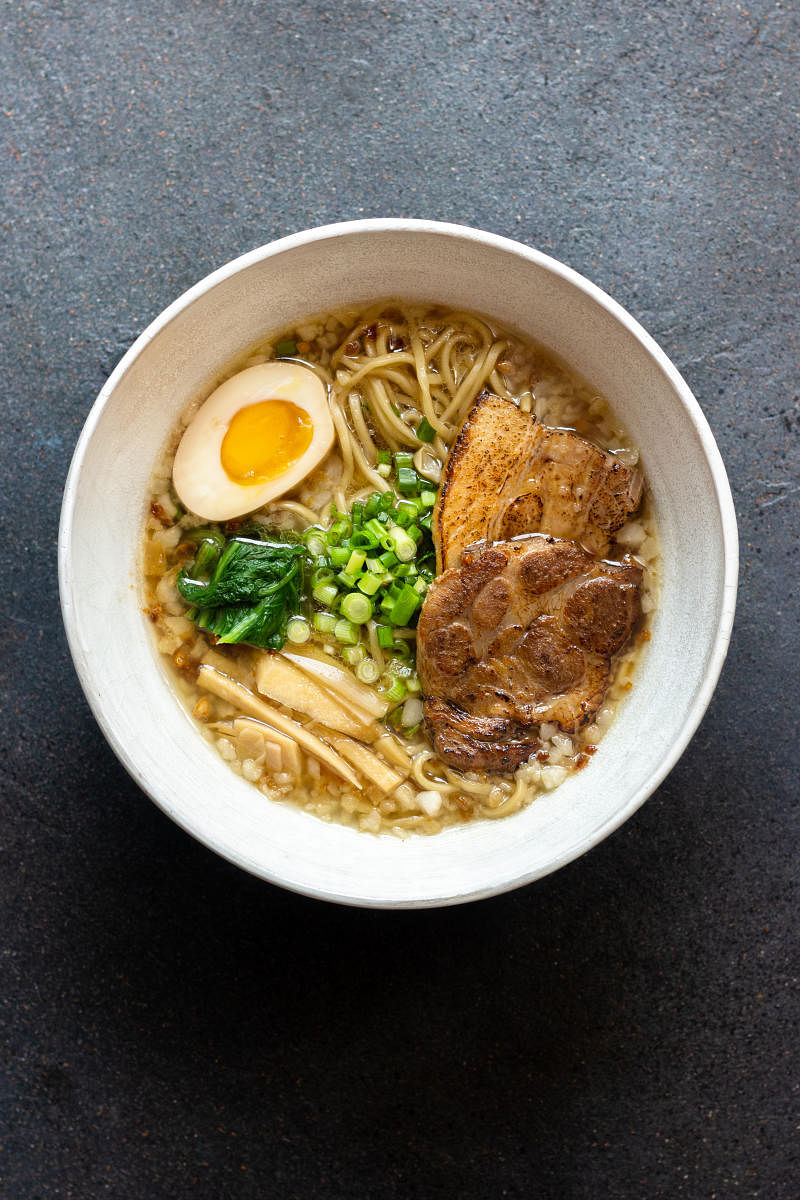
Ramen is a noodle soup but not every noodle soup is Ramen. It’s perhaps in this distinction that the soaring popularity of Ramen lies. A comfort food, it was introduced to Japan by the Chinese, some say by migrants in the 1880s, others credit it to soldiers during World War II. Long story short, it has become a cult dish in Japan and is now conquering hearts the world over.
And should you be struggling to fix a bowl of Ramen at home, hear what chef Kavan Kuttappa from Bengaluru has to say: “Any Ramen needs to have five components for it to be called Ramen. It needs to have soup, noodles, tare (or, the seasoning element), toppings (meats, veggies, seafood), and flavouring oil.”
This is the basic anatomy of Ramen (pronounced as raa-muhn). Play around with these five components and you’ll get different types of Ramen. However, what makes a bowl of Ramen truly hearty is how each ingredient is prepped, paired, and put together. From flavours to textures and aroma — everything should sing in harmony, insists Kuttappa, who is selling close-to-authentic Ramen in the city on weekends.
“Ramen stands out from, let’s say, Thukpa because it makes use of alkaline noodles,” he begins. Wheat-based, these noodles are dipped in kansui, a solution of water and alkaline salts like baking soda. The noodles, thus, come out to be chewy and springy, and can stay in the soup without going soggy. “Ramen can’t be made from rice noodles,” he cautions.
You can make Ramen noodles at home too, using a pasta machine or by rolling the dough and cutting it into strips. “Since Ramen noodles are made from a low-hydration dough, they are harder to work with but they are not undoable,” Kuttappa clarifies.
Moving to the soup. “Ideally, the Ramen soup comes from a bone broth and it’s sometimes fortified with dashi (stock) made from seaweed. Together, they build up the umami flavour.”
The soup can be clear or cloudy thick but the consistency chosen has a bearing on the noodles used. He explains, “The classic Tonkotsu Ramen is a heavy broth and it makes use of ultra-fine noodles. Since these noodles have low hydration, they absorb and hold the soup better. On the other hand, slightly thicker noodles go into the Miso Ramen. The miso paste used in this dish not only gives it an umami flavour but also adds thickness to the broth, which is enough to stick on the noodles.”
If Ramen bowls look so inviting, it’s because of a multitude of colourful toppings that go on them. “A lot of Japanese food is bound by rules but Ramen is free-play. You can experiment with different toppings,” he says. Grilled slices of pork, chicken and duck are popular choices. Soft-boiled eggs marinated in a mixture of soy is another favourite. Vegetarians can try blanched spinach, partially-cooked broccoli, roasted carrots and corns or marinated tofu slices.
While the soup, noodles and toppings provide body to Ramen, the soul lies in the tare and oil, fans say. Soy, salt and miso paste are the most commonly used seasonings, or tare.
As for the oil, he shares an easy list: “You can work with chicken or pork fat. Vegetarians can use aromatics like ginger oil, ginger-garlic oil, scallion oil, onion oil. Rosemary or thyme-infused oil will lend Western flavours while curry leaves oil will tread on the Indian side.” If this sounds too much work, just use chilli oil.
When the components are ready, add some tare and oil to the bowl, pour soup on top of them, drop the noodles, place the toppings – in this order. “By the time your soup gets ‘scalding’ hot, your noodles should be cooked, drained and ready to go in. Every noodle has a definitive cooking time, so watch out. You don’t want them overcooked,” he signs off on that important note.